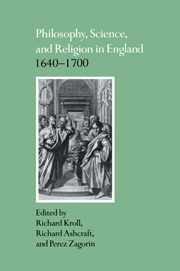Book contents
- Frontmatter
- Contents
- Notes on contributors
- Preface
- 1 Introduction
- Part I The Cambridge Platonists: philosophy at mid century
- Part II The Restoration settlement
- 7 Latitudinarianism and toleration: historical myth versus political history
- 8 The intellectual sources of Robert Boyle's philosophy of nature: Gassendi's voluntarism and Boyle's physico-theological project
- 9 Latitudinarianism and the “ideology” of the early Royal Society: Thomas Sprat's History of the Royal Society (1667) reconsidered
- 10 Locke and the latitude-men: ignorance as a ground of toleration
- 11 John Locke and latitudinarianism
- Index
11 - John Locke and latitudinarianism
Published online by Cambridge University Press: 05 November 2011
- Frontmatter
- Contents
- Notes on contributors
- Preface
- 1 Introduction
- Part I The Cambridge Platonists: philosophy at mid century
- Part II The Restoration settlement
- 7 Latitudinarianism and toleration: historical myth versus political history
- 8 The intellectual sources of Robert Boyle's philosophy of nature: Gassendi's voluntarism and Boyle's physico-theological project
- 9 Latitudinarianism and the “ideology” of the early Royal Society: Thomas Sprat's History of the Royal Society (1667) reconsidered
- 10 Locke and the latitude-men: ignorance as a ground of toleration
- 11 John Locke and latitudinarianism
- Index
Summary
Between the late 1650s and the early 1680s John Locke came to know many of the leading latitudinarians. He was almost certainly a member of Benjamin Whichcote's congregation at St. Lawrence Jewry. He was probably one of the circle of intellectuals, including several latitudinarians, who gathered at the house of the Anglican Unitarian Thomas Firmin. He also met latitudinarians in Oxford colleges, in London society, and at meetings of the Royal Society. He became friends with John Mapletoft and Thomas Grigg, describing Grigg privately in 1670 as “vir optimus.” Isaac Barrow's death in 1677 Locke lamented as robbing him of a “very considerable” friend. He was close to Edward Fowler, who visited him during his final illness in 1704, and in 1678 Locke sent his regards through Mapletoft to “our friends” Whichcote and Fowler. He was especially close to Robert Boyle, his greatly admired correspondent for thirty years on religious and scientific matters, and to John Tillotson, the “great and candid searcher after truth” whose death in 1694 Locke mourned as leaving him virtually no one he could consult on “doubtful points of divinity.” From about 1681 Locke also became very close to Damaris Cudworth, daughter of the Cambridge Platonist Ralph Cudworth; it was in her house that Locke lived for most of the last fourteen years of his life.
By the time of his death in 1704 Locke's personal library collection included over a hundred separate works by contemporary latitudinarians, and many more by their Tew Circle and Cambridge Platonist forefathers, such as Chillingworth, Hales, More and Smith.
- Type
- Chapter
- Information
- Philosophy, Science, and Religion in England 1640–1700 , pp. 253 - 282Publisher: Cambridge University PressPrint publication year: 1992
- 8
- Cited by



